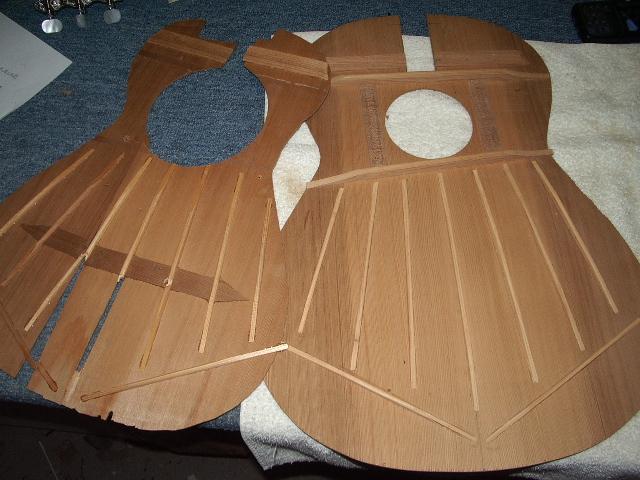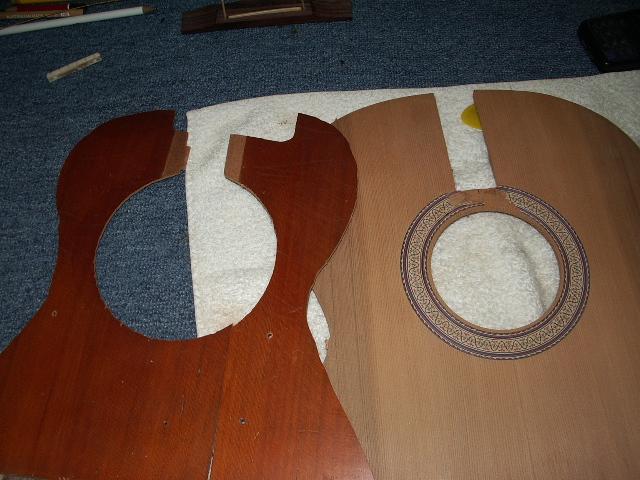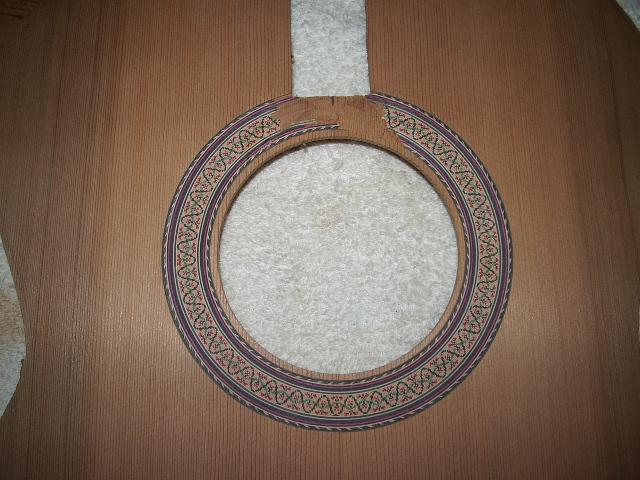Guitar Top replacement
- Taffy Evans
- Blackwood
- Posts: 1077
- Joined: Wed Apr 30, 2008 6:54 pm
- Location: Charters Towers North Queensland
Brilliant work Taffy,
Leaving the original bindings in place was a very clever move. Any extra work in fitting the top this way is more than compensated for just in the finishing process. Well done and thank you for sharing, it's this sort of input that makes the ANZLF stand out as one of the best stringed instrument related forums on the net.
Cheers
Kim
Leaving the original bindings in place was a very clever move. Any extra work in fitting the top this way is more than compensated for just in the finishing process. Well done and thank you for sharing, it's this sort of input that makes the ANZLF stand out as one of the best stringed instrument related forums on the net.
Cheers
Kim
- Taffy Evans
- Blackwood
- Posts: 1077
- Joined: Wed Apr 30, 2008 6:54 pm
- Location: Charters Towers North Queensland
Thanks for the comments Kim.
Martin, the pickup is not the thin piezo strip we are accustomed to, and I've never bothered to see how its contructed. The bridge slot is the usual width with six holes 5mm [aprox] in the bottom under the string location. Fed up into these holes from inside the guitar are six round slugs about 5mm diameter that are sitting in an aluminium casting the size of the cut out in the top by about 10mm deep. The slugs sit up through the top and lie up against a steel shim in the bottom of the bridge slot onto which the saddle sits. Screws go through he top of the bridge and locate into threaded holes in the aluminium casting, which in turn holds the whole assembly in place.
I'm sure somebody out there has a better description, but that how I see it.
Martin, the pickup is not the thin piezo strip we are accustomed to, and I've never bothered to see how its contructed. The bridge slot is the usual width with six holes 5mm [aprox] in the bottom under the string location. Fed up into these holes from inside the guitar are six round slugs about 5mm diameter that are sitting in an aluminium casting the size of the cut out in the top by about 10mm deep. The slugs sit up through the top and lie up against a steel shim in the bottom of the bridge slot onto which the saddle sits. Screws go through he top of the bridge and locate into threaded holes in the aluminium casting, which in turn holds the whole assembly in place.
I'm sure somebody out there has a better description, but that how I see it.
Taff
Thanks Taffy, that's really inspiring to see something that I would have thought was a basket case being restored to sounding better than new.
How was your bridge plate different from Matons? Thicker or larger footprint, and by how much?
And if it's not a trade secret, do you mind saying what a repair like that would cost. Seems to me you'd really have to love that guitar to make it worth while.
How was your bridge plate different from Matons? Thicker or larger footprint, and by how much?
And if it's not a trade secret, do you mind saying what a repair like that would cost. Seems to me you'd really have to love that guitar to make it worth while.
- Taffy Evans
- Blackwood
- Posts: 1077
- Joined: Wed Apr 30, 2008 6:54 pm
- Location: Charters Towers North Queensland
Hi Allen
The new bridge plate was different in that maple was used instead of the unknown timber used; at times I have pulled plates made of ply out of guitars for replacement. One would think that due to the laminations such a plate would be strong, but the tops still pulled up. The other difference was, as you said, a bigger foot print in front of the pickup slot and some behind the bridge itself.
The cost, I think I charged $500 plus and assessed this on:
• The difficulty factor [not high]
• Cost of materials [ bugger all]
• The good delivery time allowed [less pressure better job]
• Simple finish applied
• What the guitar’s worth
• And, possibly the most important consideration, in this case, I wanted to do the job. At times there are still job’s I’m still learning on so I don’t expect the customer to pay while I’m scratching my head. But next time……………
Maton advised me that they would have had to charge twice that, and I can understand that.
I have done this type of work on other guitars and mandolins, and I’m part way through a Yari classical top swap at the moment using the same Cedar. The mandolin I can’t remember the cost, it’s possible 20 years ago, I’ll post some pics, pressed ply to carved Cedar. The guitar repair cost the customer around $1500.00. This job entailed removing the back for repair, repairing the split sides and removing the top and replacing it. I also transferred the Rosette from one top to the other.
Phew, sorry Allen a bit long winded. Thanks for your interest.
This got left out of the picture tute, sorry.
The top was also a whisker thicker to be higher than the binding, so that the binding rubber strip pulled down on to the top and not the plastic binding. The rubber also pulled the sides into the top ensuring a good fit.
I made a template from the old top to assist in the routing of the pickup hole, and marking of the bridge location.
After that it was a matter of just finishing as one does when building a guitar, luckily the Maton finish was one of the thin matt lacquer finishes, I used shellac and hand applied wax buffed to a slight luster.
The new bridge plate was different in that maple was used instead of the unknown timber used; at times I have pulled plates made of ply out of guitars for replacement. One would think that due to the laminations such a plate would be strong, but the tops still pulled up. The other difference was, as you said, a bigger foot print in front of the pickup slot and some behind the bridge itself.
The cost, I think I charged $500 plus and assessed this on:
• The difficulty factor [not high]
• Cost of materials [ bugger all]
• The good delivery time allowed [less pressure better job]
• Simple finish applied
• What the guitar’s worth
• And, possibly the most important consideration, in this case, I wanted to do the job. At times there are still job’s I’m still learning on so I don’t expect the customer to pay while I’m scratching my head. But next time……………
Maton advised me that they would have had to charge twice that, and I can understand that.
I have done this type of work on other guitars and mandolins, and I’m part way through a Yari classical top swap at the moment using the same Cedar. The mandolin I can’t remember the cost, it’s possible 20 years ago, I’ll post some pics, pressed ply to carved Cedar. The guitar repair cost the customer around $1500.00. This job entailed removing the back for repair, repairing the split sides and removing the top and replacing it. I also transferred the Rosette from one top to the other.
Phew, sorry Allen a bit long winded. Thanks for your interest.
This got left out of the picture tute, sorry.
The top was also a whisker thicker to be higher than the binding, so that the binding rubber strip pulled down on to the top and not the plastic binding. The rubber also pulled the sides into the top ensuring a good fit.
I made a template from the old top to assist in the routing of the pickup hole, and marking of the bridge location.
After that it was a matter of just finishing as one does when building a guitar, luckily the Maton finish was one of the thin matt lacquer finishes, I used shellac and hand applied wax buffed to a slight luster.
Taff
Thanks Taffy. Not long winded at all. I find it really fascinating. I'm getting more and more people asking if I'll fix this or that for them, but I try my best to put them off unless it's really interesting. So far I haven't charged anything, as it's certainly a learning experience for me, and I don't have a clue at what one would charge if they were making there bread and butter from it.
-
Paul B
- Taffy Evans
- Blackwood
- Posts: 1077
- Joined: Wed Apr 30, 2008 6:54 pm
- Location: Charters Towers North Queensland
Who is online
Users browsing this forum: No registered users and 4 guests


